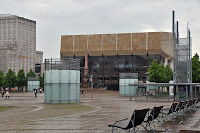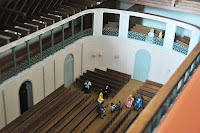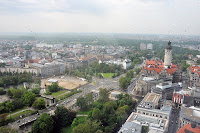This morning we took the train from Dresden to Leipzig, about an hour and ten minutes' journey. The Leipzig station is very large and contains a multilevel shopping center. Unexpectedly, the trains come and go above the three shopping levels. Our Leipzig guide met us on the platform.
A sign in the railway station for the world-famous Leipzig Gewandhaus Orchestra. We'll see more about the Gewandhaus later.
Most European stations have a shop or stall selling flowers, but this one is in a league of its own.
We began our walking tour just as it began to rain. Several blocks away, at the rear of the opera house, we came to this monument to Richard Wagner.
We saw this tall building as we were walking past the opera house. It's part of MDR, Mitteldeutscher Rundfunk (Central German Broadcasting). We're to have our morning coffee break in a restaurant high atop this building.
Another fancy clock, this one with two sturdy Heroes of Socialist Labor striking a bell with their hammers. The Communists have tweaked Virgil's omnia vincit amor (love conquers all) quotation into omnia vincit labor (work conquers all).
Across the street is the opera house, not very colorful on a rainy day.
Across the square from the opera house is the Gewandhaus concert hall. The second picture above is taken from in front of the Gewandhaus. The green cylindrical structures in the square appear to be exhaust ducts from a parking garage below the square.
Gewand means clothing or garment in German. The original Gewandhaus was a building in which garments or textiles were traded. Part of the building was a concert hall, so the orchestra was known as Gewandhaus Orchester. The name persists, and this concert hall is the third one to be called Gewandhaus.
From the shelter of the Gewandhaus's entrance, we looked at a church being reconstructed. It was damaged during World War II, but the Communists demolished it rather than repair it. They had no interest in assisting the Church, regardless of the historic significance of the building. The new building is modern, not a reproduction of the original. The spire leans intentionally, as a echo of the demolition of the original church.
A poster for an upcoming Gewandhaus Orchestra concert.
We walked over to the building where Felix Mendelssohn lived. He had a spacious apartment on the second floor; we learned about him and his family while sitting in his drawing room. The room is still used for musical performances.
Mendelssohn was anything but a starving artist. His parents were wealthy, and he could afford a stylish home.
Score in Mendelssohn's hand for the soprano aria "Hear ye, Israel" from the oratorio Elijah.
In addition to music, Mendelssohn was a talented artist. The Mendelssohn House museum contains a collection of his original watercolors. On the left is the Rheinfall near Schaffenhausen in Switzerland; on the right is Lucerne, Switzerland.
In the museum is a model of the original Gewandhaus. Through the cutout in the roof we can see a model of the original concert hall.
Strangely, very few of the seats face the stage. Most are arranged in long rows at right angles to the stage, facing each other. Hearing the music was apparently a secondary consideration, the primary one being to see the others in the audience and to be seen by them.
Gabriel working his cell phone, most likely arranging something really interesting for us to see.
It had stopped pouring rain when we left, so we were able to appreciate the house's garden. That's a bust of Mendelssohn, of course.
A banner announcing the Sunday brunch concerts held in the Mendelssohn house.
Then it was back past the Gewandhaus to the tall building beyond, where we had coffee and pastries in the Panorama Tower. The view was magnificent even on a day that still threatened rain.
The food matched the view.
Next we'll walk through the old city to see the Bach museum and the Thomaskirche.
Subscribe to:
Post Comments (Atom)











































No comments:
Post a Comment